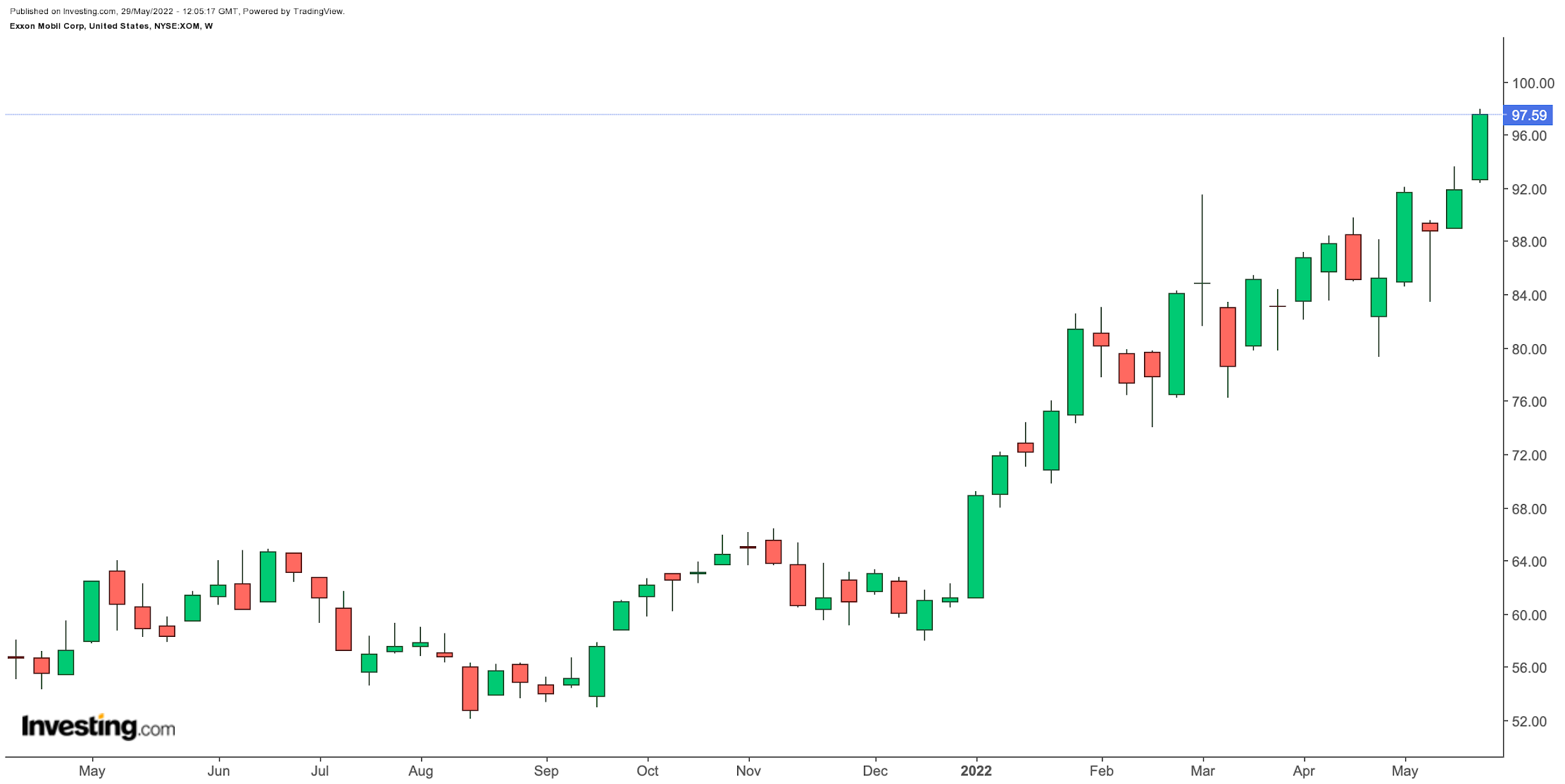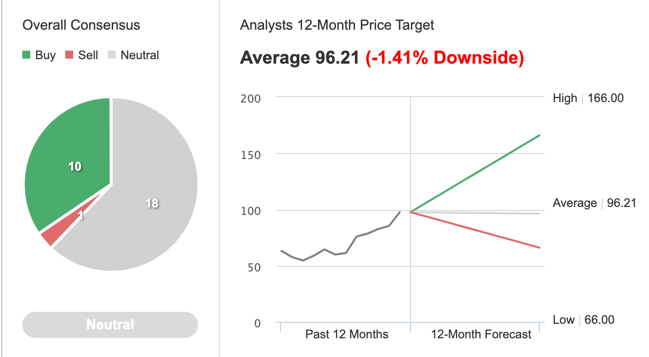- Exxon Mobil shares have returned almost 60% since the start of 2022
- Tight supply/demand balance for oil products creates significant advantage for oil giant
- Long-term investors could consider buying XOM stock at current levels.
- Looking for more top-rated stock ideas to add to your portfolio? Members of InvestingPro+ get exclusive access to our research tools, data, and pre-selected screeners. Learn More »
Shareholders in the energy giant Exxon Mobil (NYSE:XOM) have seen the value of their investment increase by 67.2% over the past 12 months and 59.5% year-to-date (YTD). By comparison, the Dow Jones US Oil and Gas Index has gained more than 55% so far this year, and saw a multi-year high on May 27. Meanwhile, the S&P 500 Index is down 12.6% YTD.

On May 27, XOM shares also went over $97 to hit a multi-year high. The stock’s 52-week range has been $52.10-$97.93. With a market capitalization (cap) of $411.1 billion, it is the largest energy name stateside.
While there are significant debates around the fossil fuel industry’s future, oil will remain an essential energy source for at least the next decade. Thus, like many of its peers, Exxon continues to benefit from a strong recovery in demand and rising oil prices.
The Irving, Texas-based energy major recently announced several new discoveries in offshore Guyana and launched the Yellowtail development, its fourth offshore oil project in the region. This $10 billion project should generate 250,000 barrels of oil per day starting in 2025.
Recent Metrics
Exxon Mobil released Q1 figures on Apr. 29. Revenue was $90.50 million, up from $59.15 billion a year ago. Earnings per share (EPS) came in at $1.28 compared to 64 cents a year ago. In the quarter, the company generated $14.8 billion cash flow from operating activities and $10.8 billion in free cash flow.
On the results, CEO Darren Woods commented:
“Earnings increased modestly, as strong margin improvement and underlying growth was offset by weather and timing impacts. The absence of these temporary impacts in March provides strong, positive momentum for the second quarter.”
Along with the earnings release, Exxon announced that it tripled the size of its share repurchase program. It will repurchase up to $30 billion shares through 2023. The stock currently offers a 3.61% dividend yield.
Prior to the release of the Q1 results, XOM stock was changing hands around $85. On May 27, it closed at $97.59, up over 14%.
What To Expect From XOM Stock
Among 29 analysts polled via Investing.com, Exxon Mobil stock has a "neutral" rating. Wall Street has a 12-month median price target of $96.21 for the stock. Such a move would suggest a decline of 1.41% from the current price. The 12-month target range stands between $66 and $166.

Source: Investing.com
On the other hand, according to a number of valuation models, including P/E or P/S multiples or terminal values, the average fair value for XOM stock on InvestingPro stands at $117.03.

Source: InvestingPro
In other words, fundamental valuation suggests shares could increase almost 20%.
We can also look at XOM’s financial health as determined by ranking more than 100 factors against peers in the energy sector.
For instance, in terms of cash flow, growth and profit, it scores 3 out of 5. Moreover, XOM stock scores 4 out of 5 in price momentum. Its overall score of 4 points is a great performance ranking.
At present, XOM’s P/E, P/B and P/S ratios are 15.9x, 2.4x and 1.3x. Comparable metrics for peers stand at 16.6x, 1.9x and 1.2x. These numbers reveal that despite the recent increase in price, the fundamental valuation for Exxon stock more or less reflects the overall valuation of its peers in the industry.
Our expectation is for XOM stock to trade in a range between $90 and $100 in the coming weeks, and then possibly start a new leg up. However, moves in the price of oil will also affect the price of Exxon shares.
Adding XOM Stock To Portfolios
Exxon Mobil bulls who are not concerned about short-term volatility could consider investing now. Their target price would be $117.03, as per the target provided by quantitative models.
Alternatively, investors could consider buying an exchange-traded fund (ETF) that has XOM stock as a holding. Examples include:
- Energy Select Sector SPDR Fund (NYSE:XLE)
- Fidelity® MSCI Energy Index ETF (NYSE:FENY)
- SPDR S&P® North American Natural Resources ETF (NYSE:NANR)
- iShares Core High Dividend ETF (NYSE:HDV)
Finally, investors who expect XOM stock to increase further in the weeks ahead could consider setting up a bull call spread.
Most option strategies are not suitable for all retail investors. Therefore, the following discussion on XOM stock is offered for educational purposes and not as an actual strategy to be followed by the average retail investor.
Bull Call Spread On Exxon Mobil Stock
Intraday Price At Time Of Writing: $97.59
In a bull call spread, a trader has a long call with a lower strike price and a short call with a higher strike price. Both legs of the trade have the same underlying stock (i.e. Exxon Mobil) and the same expiration date.
The trader wants XOM stock to increase in price. In a bull call spread, both the potential profit and the potential loss levels are limited. The trade is established for a net cost (or net debit), which represents the maximum loss.
Today’s bull call spread trade involves buying the August 19 expiry 100 strike call for $4.75 and selling the 105 strike call for $2.85.
Buying this call spread costs the investor around $1.90, or $190 per contract, which is also the maximum risk for this trade.
We should note that the trader could easily lose this amount if the position is held to expiry and both legs expire worthless, i.e., if the XOM stock price at expiration is below the strike price of the long call (or $100 in our example).
To calculate the maximum potential gain, we can subtract the premium paid from the spread between the two strikes, and multiply the result by 100. In other words: ($5.00 – $1.90) x 100 = $310.
The trader will realize this maximum profit if the Exxon Mobil stock price is at or above the strike price of the short call (higher strike) at expiration (or $105 in our example).
Such a strategy may be appropriate for traders whose portfolio allow for a risk and return profile offered by options positions.
***
Interested in finding your next great stock or ETF idea? InvestingPro+ gives you the chance to screen through 135K+ stocks to find the fastest growing or most undervalued stocks in the world, with professional data, tools, and insights. Learn More »
